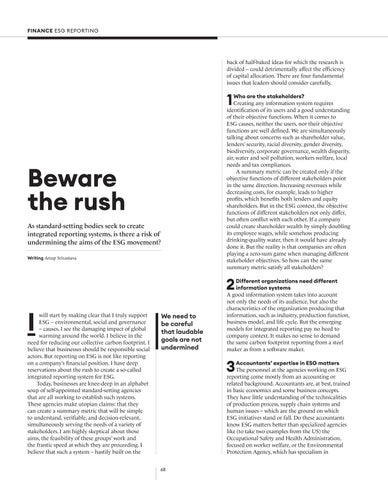FINANCE ESG REPORTING
back of half-baked ideas for which the research is divided – could detrimentally affect the efficiency of capital allocation. There are four fundamental issues that leaders should consider carefully.
1
Who are the stakeholders? Creating any information system requires identification of its users and a good understanding of their objective functions. When it comes to ESG causes, neither the users, nor their objective functions are well defined. We are simultaneously talking about concerns such as shareholder value, lenders’ security, racial diversity, gender diversity, biodiversity, corporate governance, wealth disparity, air, water and soil pollution, workers welfare, local needs and tax compliances. A summary metric can be created only if the objective functions of different stakeholders point in the same direction. Increasing revenues while decreasing costs, for example, leads to higher profits, which benefits both lenders and equity shareholders. But in the ESG context, the objective functions of different stakeholders not only differ, but often conflict with each other. If a company could create shareholder wealth by simply doubling its employee wages, while somehow producing drinking-quality water, then it would have already done it. But the reality is that companies are often playing a zero-sum game when managing different stakeholder objectives. So how can the same summary metric satisfy all stakeholders?
Beware the rush As standard-setting bodies seek to create integrated reporting systems, is there a risk of undermining the aims of the ESG movement? Writing Anup Srivastava
2
I
will start by making clear that I truly support ESG – environmental, social and governance – causes. I see the damaging impact of global warming around the world. I believe in the need for reducing our collective carbon footprint. I believe that businesses should be responsible social actors. But reporting on ESG is not like reporting on a company’s financial position. I have deep reservations about the rush to create a so-called integrated reporting system for ESG. Today, businesses are knee-deep in an alphabet soup of self-appointed standard-setting agencies that are all working to establish such systems. These agencies make utopian claims: that they can create a summary metric that will be simple to understand, verifiable, and decision-relevant, simultaneously serving the needs of a variety of stakeholders. I am highly skeptical about those aims, the feasibility of these groups’ work and the frantic speed at which they are proceeding. I believe that such a system – hastily built on the
We need to be careful that laudable goals are not undermined
Different organizations need different information systems A good information system takes into account not only the needs of its audience, but also the characteristics of the organization producing that information, such as industry, production function, business model, and life cycle. But the emerging models for integrated reporting pay no heed to company context. It makes no sense to demand the same carbon footprint reporting from a steel maker as from a software maker.
3
Accountants’ expertise in ESG matters The personnel at the agencies working on ESG reporting come mostly from an accounting or related background. Accountants are, at best, trained in basic economics and some business concepts. They have little understanding of the technicalities of production process, supply chain systems and human issues – which are the ground on which ESG initiatives stand or fall. Do these accountants know ESG matters better than specialized agencies like (to take two examples from the US) the Occupational Safety and Health Administration, focused on worker welfare, or the Environmental Protection Agency, which has specialism in
68
068-069_Dialogue_Q1_2024.indd 68
25/10/2023 16:45
